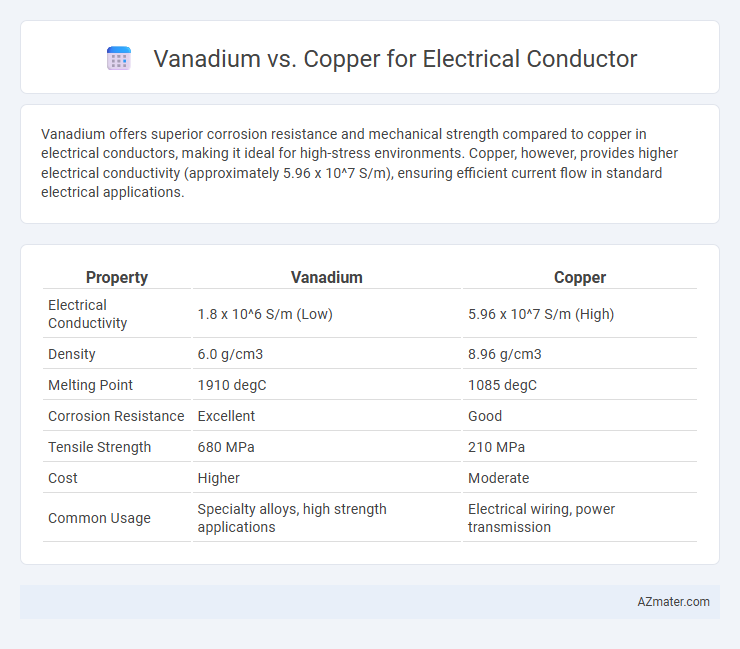Vanadium offers superior corrosion resistance and mechanical strength compared to copper in electrical conductors, making it ideal for high-stress environments. Copper, however, provides higher electrical conductivity (approximately 5.96 x 10^7 S/m), ensuring efficient current flow in standard electrical applications.
Table of Comparison
| Property | Vanadium | Copper |
|---|---|---|
| Electrical Conductivity | 1.8 x 10^6 S/m (Low) | 5.96 x 10^7 S/m (High) |
| Density | 6.0 g/cm3 | 8.96 g/cm3 |
| Melting Point | 1910 degC | 1085 degC |
| Corrosion Resistance | Excellent | Good |
| Tensile Strength | 680 MPa | 210 MPa |
| Cost | Higher | Moderate |
| Common Usage | Specialty alloys, high strength applications | Electrical wiring, power transmission |
Overview of Vanadium and Copper as Electrical Conductors
Vanadium and copper differ significantly in their electrical conductivity, with copper exhibiting one of the highest conductivities among metals, making it the preferred choice for electrical wiring and components. Vanadium, while possessing excellent strength and corrosion resistance, has substantially lower electrical conductivity than copper, limiting its use in pure conductor applications. Copper's combination of high conductivity, thermal performance, and ductility establishes it as the standard in electrical systems, whereas vanadium is more commonly used as an alloying element to enhance mechanical properties rather than as a primary conductor.
Electrical Conductivity Comparison: Vanadium vs Copper
Copper exhibits significantly higher electrical conductivity, approximately 59.6 MS/m (megasiemens per meter) at 20degC, compared to vanadium's much lower conductivity around 1.8 MS/m. This large difference makes copper the preferred choice for electrical conductors due to its superior ability to efficiently transmit electric current with minimal resistive losses. Vanadium's limited conductivity restricts its practical use in standard electrical wiring despite its strength and corrosion resistance.
Mechanical Strength and Durability
Vanadium exhibits superior mechanical strength compared to copper, making it highly resistant to deformation under stress in electrical conductor applications. While copper offers excellent electrical conductivity, vanadium alloys provide enhanced durability and resistance to wear, corrosion, and fatigue, extending the lifespan of conductors in harsh environments. Vanadium's combination of high tensile strength and robust corrosion resistance makes it ideal for applications where mechanical integrity and long-term durability are critical.
Corrosion Resistance and Longevity
Vanadium exhibits superior corrosion resistance compared to copper, particularly in aggressive environments, due to its stable oxide layer that prevents degradation. Copper, while an excellent electrical conductor, is more prone to oxidation and corrosion over time, especially in moist or acidic conditions, which can reduce its longevity. The enhanced corrosion resistance of vanadium contributes to longer service life and reduced maintenance requirements in electrical applications demanding durability.
Thermal Conductivity and Heat Management
Copper outperforms vanadium in thermal conductivity, with copper exhibiting approximately 401 W/m*K compared to vanadium's 30 W/m*K. This significant difference enables copper to dissipate heat more efficiently, making it the preferred choice for electrical conductors requiring superior heat management. Vanadium's lower thermal conductivity limits its effectiveness in applications where rapid heat transfer is critical.
Weight and Density Considerations
Vanadium's density of approximately 6.0 g/cm3 is significantly lower than copper's density of 8.96 g/cm3, making vanadium a lighter alternative for electrical conductors. This lower density translates to less overall weight in applications where conductor mass is critical, such as aerospace or portable electronics. Despite its lighter weight, copper maintains superior electrical conductivity, influencing the trade-off decisions between weight savings and conductivity performance.
Cost and Economic Feasibility
Copper remains the leading choice for electrical conductors due to its superior conductivity and well-established supply chain, despite higher raw material costs compared to vanadium. Vanadium offers potential cost advantages in niche applications where its higher strength-to-weight ratio can reduce overall system costs, but its lower electrical conductivity limits widespread adoption. Economic feasibility heavily favors copper in standard electrical wiring, though vanadium's use is growing in specialized, high-performance contexts where cost-benefit balances differently.
Applications in Electrical Engineering
Vanadium exhibits superior corrosion resistance and high-temperature stability, making it suitable for specialized electrical engineering applications such as high-performance transformers and advanced superconductors. Copper, known for its excellent electrical conductivity and cost-effectiveness, remains the dominant choice for wiring, cables, and electrical connectors in conventional power distribution and electronic devices. The integration of vanadium alloys complements copper in environments demanding enhanced mechanical strength and thermal endurance, particularly in aerospace and military-grade electrical systems.
Environmental Impact and Sustainability
Vanadium offers superior corrosion resistance and longer lifespan compared to copper, reducing the frequency of replacement and associated environmental disruption. Copper mining and refining generate significant greenhouse gas emissions and toxic waste, whereas vanadium extraction, often a byproduct of steel production, benefits from utilizing existing industrial waste streams. Sustainability efforts favor vanadium's potential for recycling and lower ecological footprint, making it a promising alternative for eco-conscious electrical conductor applications.
Future Trends and Innovations in Electrical Conductors
Vanadium, known for its high strength-to-weight ratio and corrosion resistance, is emerging as a promising alternative to copper in electrical conductors, especially for specialized applications requiring durability and lightweight materials. Innovations in nanotechnology and alloy development are enhancing vanadium's electrical conductivity, potentially surpassing copper's performance in high-temperature and harsh environments. Future trends indicate increased research into vanadium-based composites and hybrid conductors, aiming to combine superior electrical properties with mechanical robustness for next-generation power transmission systems.

Infographic: Vanadium vs Copper for Electrical Conductor
 azmater.com
azmater.com